
Egregia menziesii
Feather Boa Kelp, Feather Boa
Harling Point, Juan de Fuca Strait, British Columbia, Canada
11 April 2020
Observed in situ & then collected at 12:25 pm PDT
Low Tide 1.6 feet at 12:51pm PDT (measured at Oak Bay Tidal Station)
Weather: Sunny, light winds, light ship generated swell, temperature 14˚, relative humidity 35%.
Phase of Moon: Waning Gibbous (Previous Phase, Full Moon, 7 Apr 2020 7:35pm PDT: Next Phase, Third Quarter, 14 Apr 2020, 3:56pm PDT).
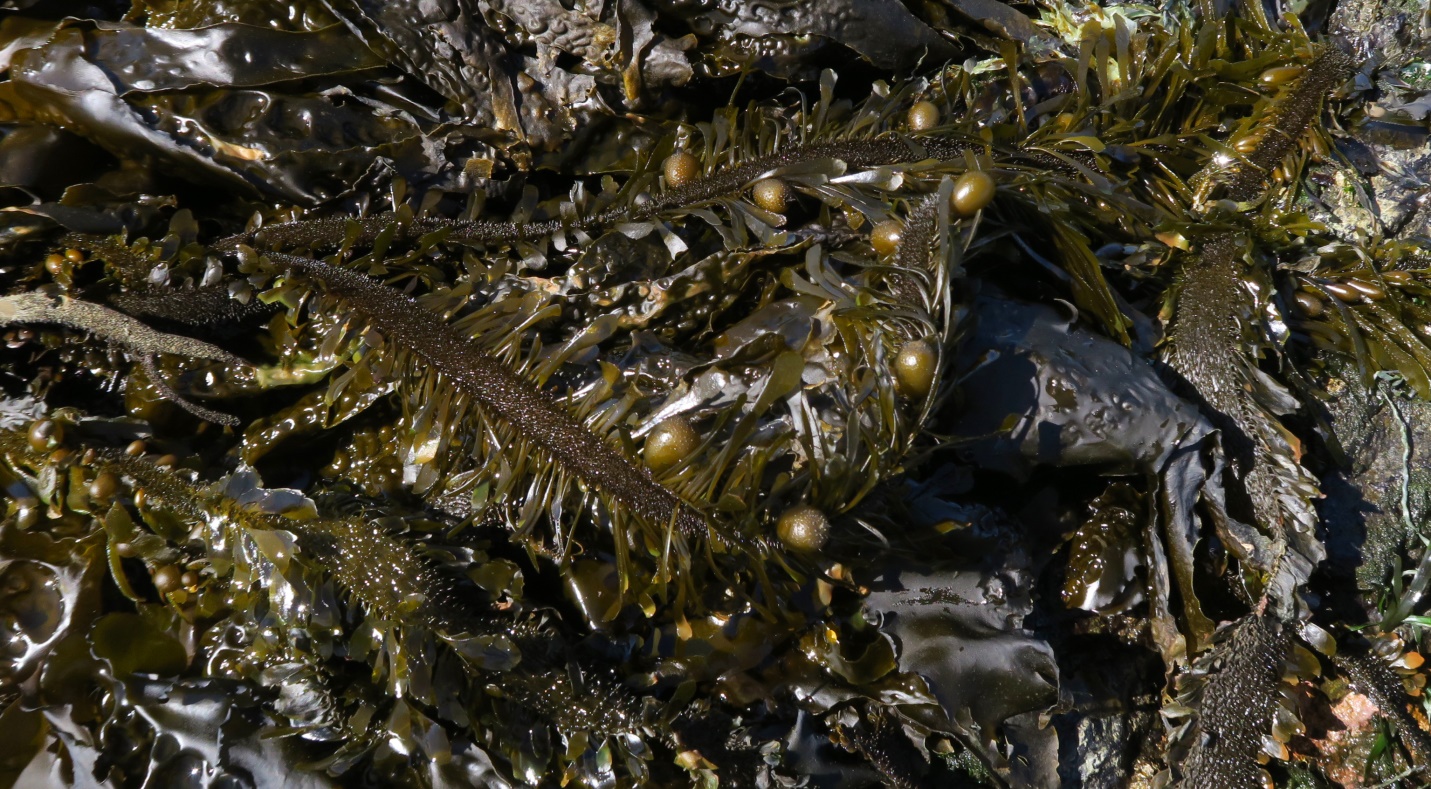
Figure 1: Egregia menziesii, Feather Boa Kelp, lying atop some Sea Cabbage (Hedophyllum sessile) as they both are exposed at low tide. Harling Point, Juan de Fuca Strait, B.C., Canada. April 11, 2020. Photo ID 27475 ©Seaweedwhisperings.com
In situ observations:
Person 1:
Long.
Does it wish it was contorted instead of straight?
Stands out from background.
Comfortable in surroundings, flopped, relaxed, not stressed.
Biggest in its habitat but unassuming.
Tiny but strong feet.
I imagined it effortlessly undulating in the ocean like a snake.
Appearance like a dragon with frills and adornments on wings head and body.
Tingle in the forehead when touching rough central stem of EM.
[Note: I later noticed that early on in my interactions I began referring to Egregia menziesii by its initials only, as “EM”. I haven’t done this with any other seaweed.]
Tickling in fingers on contact with side fronds.
The floats feel like the smoothness of a woman’s breast.
Feels like I’m climbing (hand over hand on a ladder or rope) as I run my hand along the stem.
Tingling in palms of hands when I grasped central stem.
Person 2:
Seashore bedrock here is covered in algal life.
Surf – swelling, in and out.
Low tide / exposed – to sun and wind and being trod upon.
Egregia looks flattened – as if it’s missing some of its dimensions.
Resting.
Waiting.
Enduring.
Holding fast.
So much life crowded in – “How can I be different”, Egregia asks?
“What niche can be mine”?
Tough.
Sturdy.
Raspy fronds.
Decorated.
Which part is me?
Whip in the water.
Tugged, but holds fast.
Tinsel-like fronds, kind of metallic feeling, thin metal-like pieces.
“Don’t mess with me!”
In the water I dance – a ribbon-y, undulating dance; out of water I’m waiting to dance again.
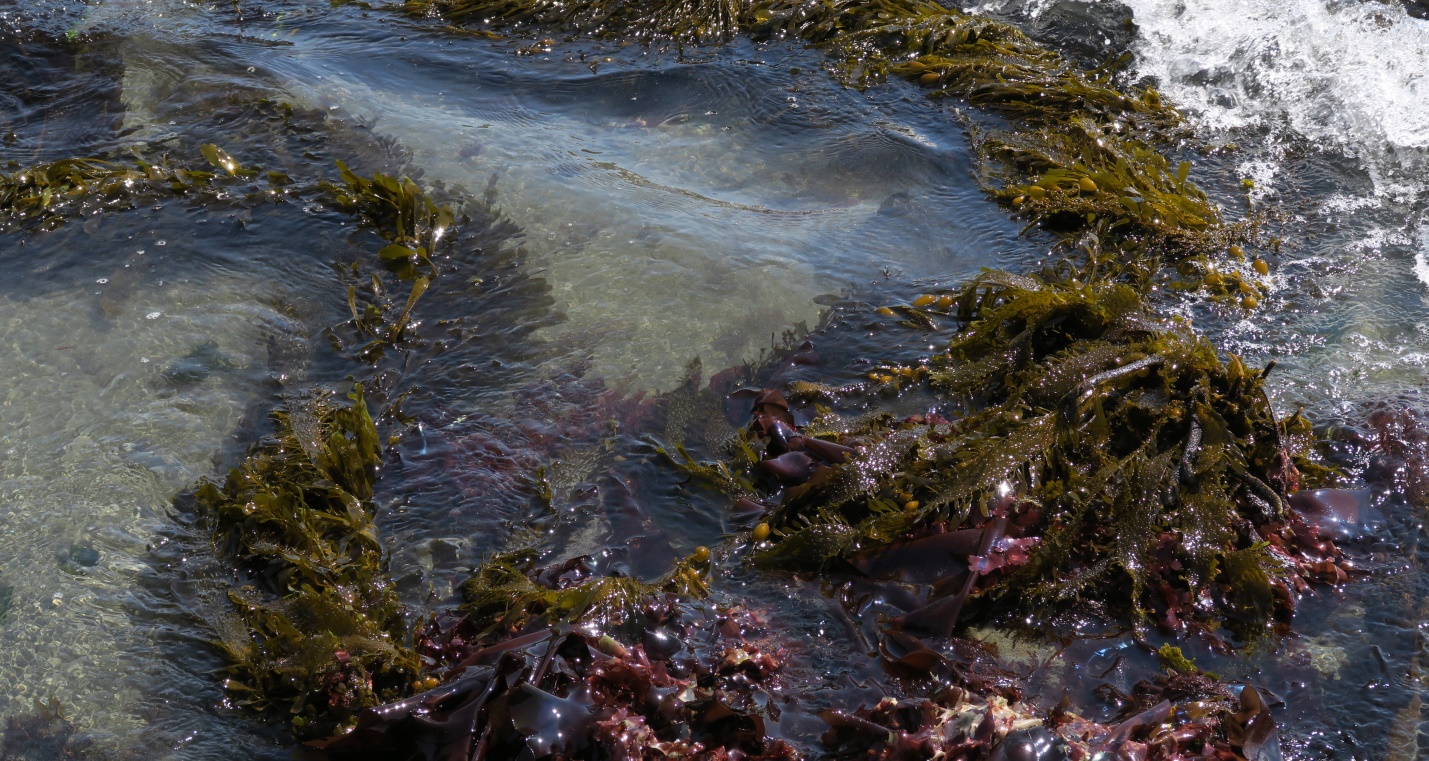 Figure
2: Only partly submerged, the long thalli of Egregia
menziesii
pictured here are bent in mid-undulation as the ocean swells roll in
to the shallows near the shoreline. Nearby red algae include
Mazzaella
splendens
and Cryptopleura
ruprechtiana.
Fishboat Bay, Juan de Fuca Strait, B.C., Canada. May 10, 2020.
Photo ID 27476 ©Seaweedwhisperings.com
Figure
2: Only partly submerged, the long thalli of Egregia
menziesii
pictured here are bent in mid-undulation as the ocean swells roll in
to the shallows near the shoreline. Nearby red algae include
Mazzaella
splendens
and Cryptopleura
ruprechtiana.
Fishboat Bay, Juan de Fuca Strait, B.C., Canada. May 10, 2020.
Photo ID 27476 ©Seaweedwhisperings.com
Observations - preparing to transport specimens from seashore:
Person 1:
Experienced a sexual twinge in penis as Person 2 was ‘feeding’ the seaweed into transport bucket.
Sexual twinge was felt behind the head of penis, along the central shaft; twinge, almost pulse of movement, a jerk of movement accompanied by tingling. A single notable twinge.
Later realized this didn’t trigger sexual feelings that persisted; it was just a single event and then gone.
Person 2:
A cabbage white butterfly, Pieris rapae, visited just now; it struck me as notable and unusual to see a butterfly here on the seashore at the low intertidal area.
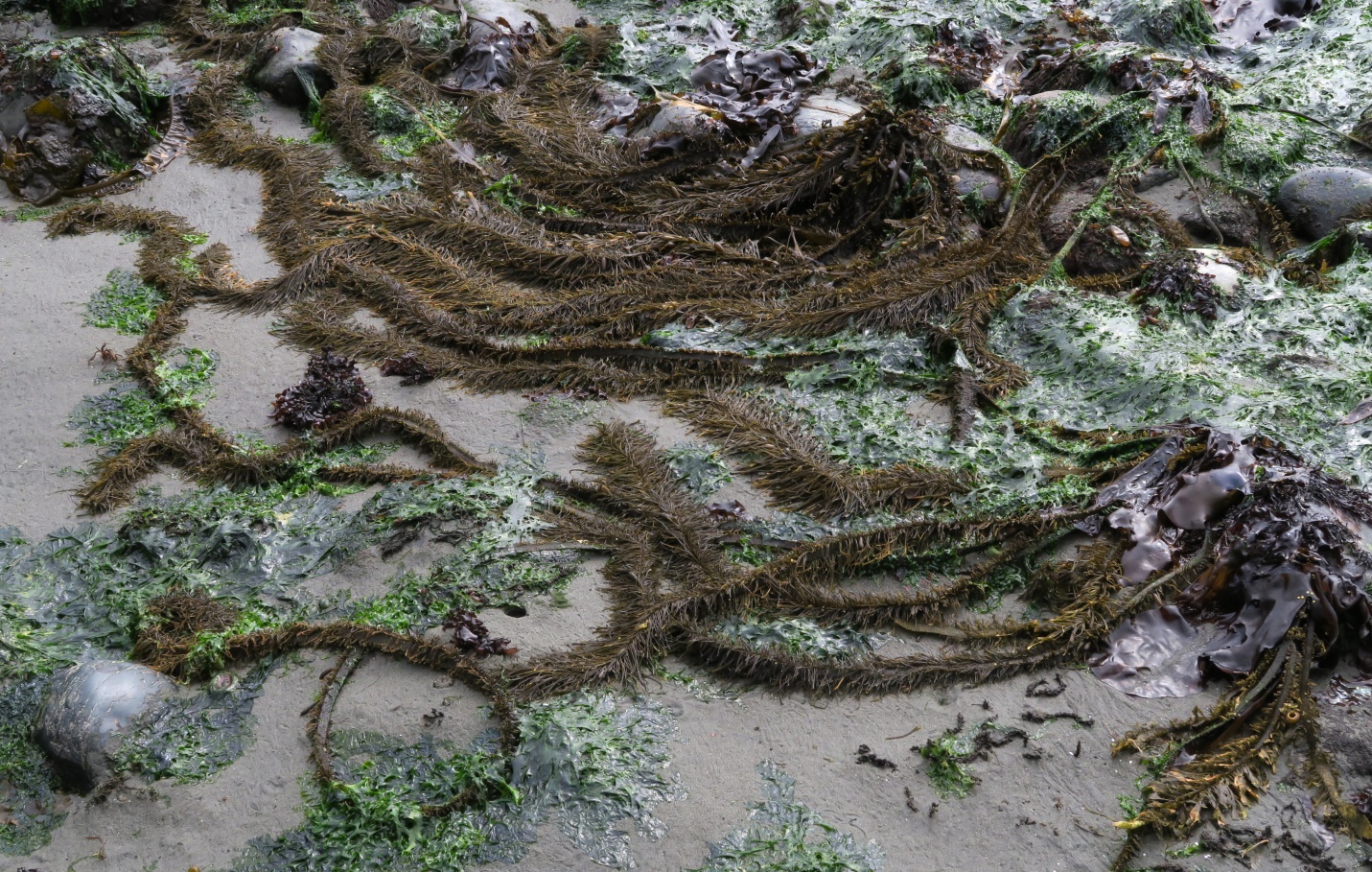
Figure 3: Exposed at a very low tide, these Feather Boas tolerate the circumstances but also relish the moment they can be dancing in the ocean once again. Many of the main thalli are 6 or 7 meters long; they would grow to 12 or 15 meters when we observed them again in mid-August. Fishboat Bay, Juan de Fuca Strait, B.C., Canada. July 6, 2020. Photo ID 27477 ©Seaweedwhisperings.com
Further Observations & Impressions:
Person 1:
Another identical sexual twinge when Person 2 took the seaweed out of the transport bucket and fed it into the observation basin at home.
It made me WANT to work with THAT same piece of seaweed and the same basin for further Whispering work.
Twisted appearance in basin; EM doesn’t like to be constrained in this way.
Side fronds look like anemone tentacles.
Looking sideways on broad central rib the small projections look like a nail brush.
Basal end of seaweed stem looks like a sawfish (a family of rays) bill; does EM slice through things?
While feeling the central blade I experienced tingling sensation in underside of arch of right foot.
Gently squeezing the floats reminds me of gently squeezing a woman’s breast.
Wondering why I’m having so many sexual thoughts or connotations.
Desire to suppress my sexual thoughts now (in retrospect this suppression was successful).
Don’t want to feel/touch EM with my face – something in this alga was keeping me away.
Startlingly sweeter than expected.
Frond taste, blah lettuce-like with a slight after bite.
Stem similar, but more like a familiar seaweed flavor as in Japanese cooking.
Overall impression – blah and uninteresting.
Wanted minimal interaction while tasting – did not want to eat EM.
Reflecting on original meaning of ‘egregious’, I see that this seaweed does “stand out” from others and is showy and much more varied in form than most other seaweeds.
Egregious = outstanding, with a positive connotation.
Reflecting on the name “feather boa” became aware, oh, this has sexual connotations (until this point, had no conscious association with the sexual connotation of the name).
Person 2:
Upon returning home to interact further with our specimens, I felt a strong thirst; I wanted a large drink of water.
I also felt a strong desire to put on my flowing, swishy-hemmed summer dress, and did so.
Many textures to this seaweed.
Reflects light on fronds and bulbs (floats).
Absorbs light, too, sucks it in and holds it, especially on the flattened main stems.
Long, very long and decorated.
We really don’t have large enough basins for you to fit comfortably within, Egregia. Apologies to you.
Three aspects noted: one, the prominent bumpy dark thick strap-like stem; two, the ‘haywire’ wiry fronds off each side of stem; three, the oval or olive shaped floats.
The question arises, “Which am I?” The strap-like core, the haywiry side fronds, the oval floats, ALL of these at once, or only one part some of the time, another part at other times? There’s a lot going on in the morphology of this seaweed.
Multi-colors: burgundy brown and olive green.
Multiple: textures / colors / shapes / facets / personalities...?
I want to swing this fancy long seaweed round and round. Does it have a strong desire to move?
Lateral fronds are stiff, surprisingly so.
Stem is stubbly and very, very tough.
Floats are smooth, slippery.
Rubbing my cheeks and chin with plant feels raspy, like a man’s chin 1 or 2 days post-shave.
Rubbing plant to my face creates a tingling sensation on skin like a scouring brush.
Very tough.
Takes much force tugging in order to break it.
In water, sliding hand along the stem is very sensual; different textures under water all give some sensual stimulation, and all are smoother, more slippery (than out of water). It is a pleasing sensual experience to glide along with Egregia under water – what would it be like to swim with Egregia?
Smell of sea / intertidal regions but fresher, not too much ammonia.
Faintly “sweet” smell.
Tough to bite through.
I don’t want the fronds in my mouth – they feel like metal or simple cellulose, no food here! Are these fronds a protection to keep predators away?
The spatulate lateral fronds almost remind me of paddles or oars – so maybe they function to move and agitate the water around this seaweed.
Chewed / macerated a piece of the stem, and then wanted only to suck juice from pulp, not swallow it whole.
“To taste” somehow became “to eat”.
Tastes simple, not much different than slightly salty saliva.
Tongue feels a bit tingly and then also cleaner after tasting this seaweed.
Crackly, crunchy texture when biting float; not appealing to taste or eat more of this part.
Then a bit later: taste lingered, and somehow makes me sleepy. My lips feel swollen from the chewing.
“Egregia”, the word, sounds raspy, edgy to say; similar to the edgy, raspy feeling fronds.
Looks like a big long “feather” but all messed up, not orderly and uniform like a bird’s.
“Feather boa” – a wrap, but this one could dress you up or it could strangle you.
Feather – bird; boa – reptile; kelp – algae/plant – a blend of many life forms to name this seaweed – multi-faceted theme arises once again.
“Menziesii” – ‘feels’ like a wrong ending like from a different world or unsuitable language.
The feather boa – it is a decoration – a seductive one, to lure you in.
Let me attract you – wait, why does Egregia need the ‘extra’? Is its natural sexuality not enough? A decoration or two or three feels as if it’s somehow needed?
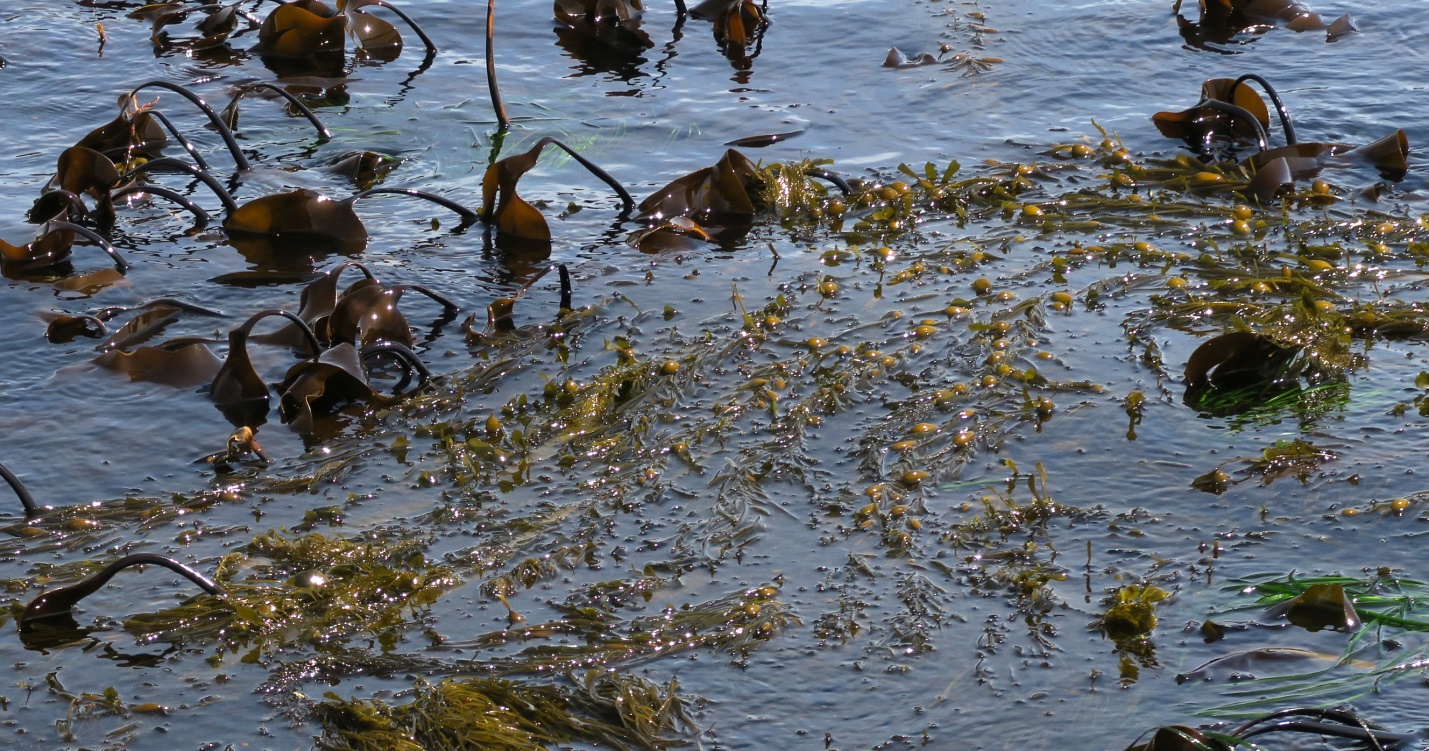
Figure 4: Egregia menziesii is seen here as it floats in the shallow waters of the low intertidal / high subtidal zone. All that is visible are the rounded pneumatocysts and the some of the numerous, slender, spatulate shaped blades; the central ‘strap’ of the thallus is submerged. Laminaria setchellii is growing nearby, with its dark brown blades draped from bowed stipes. Fishboat Bay, Juan de Fuca Strait, B.C., Canada. May 10, 2020. Photo ID 27478 ©Seaweedwhisperings.com
Listening Further:
Person 1:
“Feather boa”, equals snake, I’d so far felt nothing related to ‘snake’ other than it’s long shape. Wait a minute! – In the water, undulating like a snake.
Undulating equals moving in and out of situations, or being engaged / disengaged and that equals possibly a lack of concentration or direction. Contrasts with the seaweed being directionally oriented related to tides and oceanic influences.
When EM is in the water it’s in its “being”, it’s manifesting itself; when it’s out of water, it’s “a fish out of water”, and it’s sorely missing its element.
In the water it has its freedom to do what it does best.
Out of water it is helplessly exposed.
Some critters / people when exposed will fight; others will just give up, flop, take whatever hits them – helpless when exposed.
When this seaweed is immersed, I imagined light shining through the beautiful fronds – this image generated joyful and peaceful feelings.
I sat with this energy and had the image of flying through the sea, flapping effortlessly, like a Brown Pelican lazily working a coastline.
Person 2:
One might hide in your forest of fronds but with a flip of the surf one is exposed – no longer hidden, too exposed, naked and unsafe.
Hold tight, grow fast, float high, find the sunlight.
Get too big – greater risk of being torn away – to die.
Dance, move, play in the water – sensual sliding and gliding.
I don’t want to be in the dark, i.e. darker room to transcribe my type notes. Even though it is easier to work there I leave my comfortable desk and chair to move to a bright room; I WANT the light. This seaweed wants the light.
Person 3:
[Note; this is a separate interaction with a 10 year old female; location was Orveas Bay, Juan de Fuca Strait, B.C., Canada]
Excitement of discovery.
Exuberance.
This Feather Boa I’m wearing makes me “even more” special.
Playfulness.
She wanted to interact / dance with her kelp.
Sensual, provocative movements (this in a girl who is normally not into girly-stuff, frills, lipstick, etc. at all).
Then she wanted others to interact with both her and her kelp – to join in her sensual dance, to pull them in with her Feather Boa. But she was already ‘there’, and the others nearby that she beckoned were not ‘attracted’.
The ‘myth’ of the snake as seducer of Eve arises.
Person 3 was notably disappointed / deflated when no one would engage with her and her feather boa in their sensual dance.
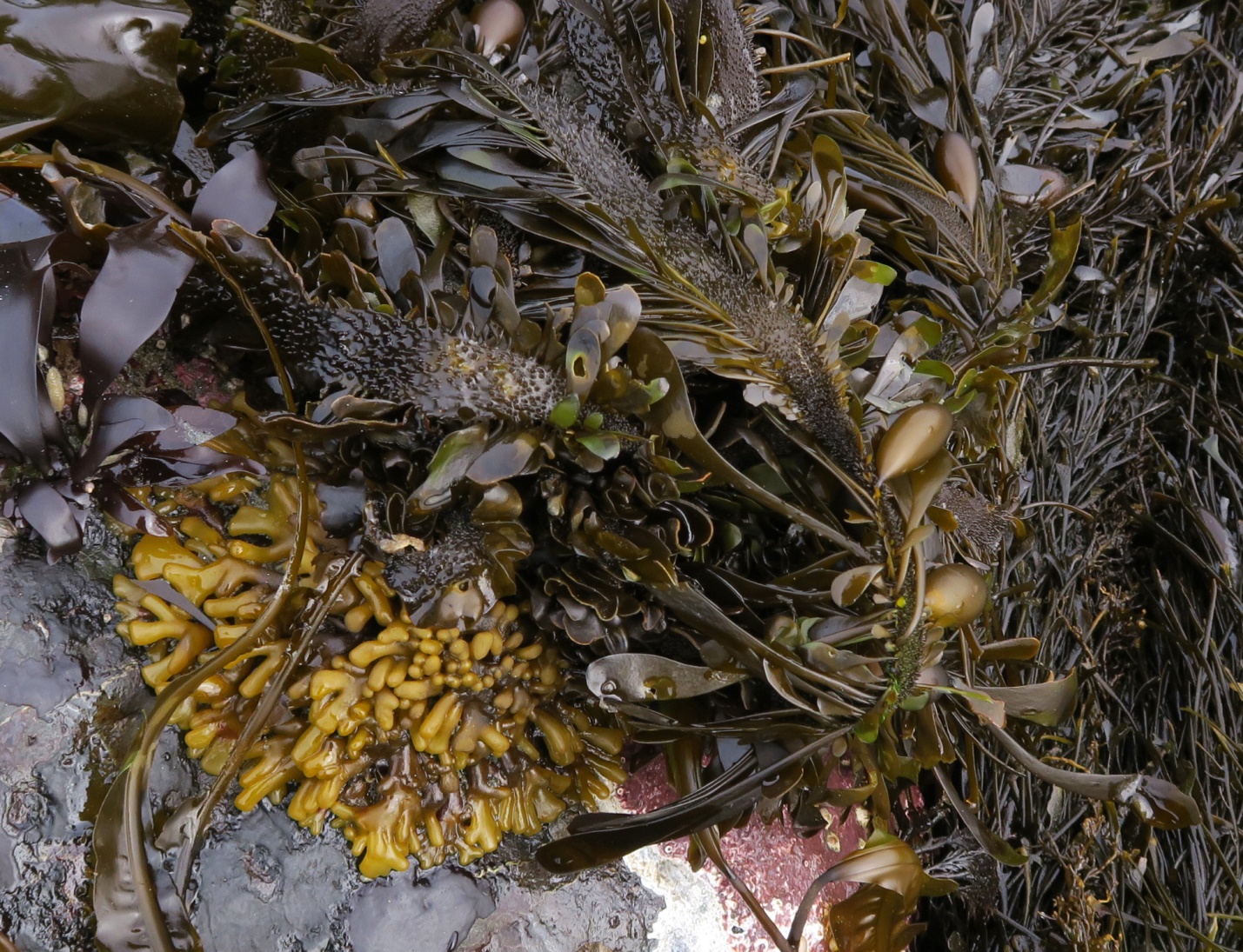
Figure 5: Egregia menziesii – this view shows the richly branched bright yellowish-brown holdfast which anchors the Egregia thalli to a seaside boulder. The holdfast looks sturdy and it truly must be to hold the long (up to 15 meter) growths of multiple Feather Boas. Here it is sharing space on the rock with some tar spot alga (shiny black patches) and some encrusting coralline algae (dusky pink). Fishboat Bay, Juan de Fuca Strait, BC. July 2, 2020. Photo ID 27479 ©Seaweedwhisperings.com
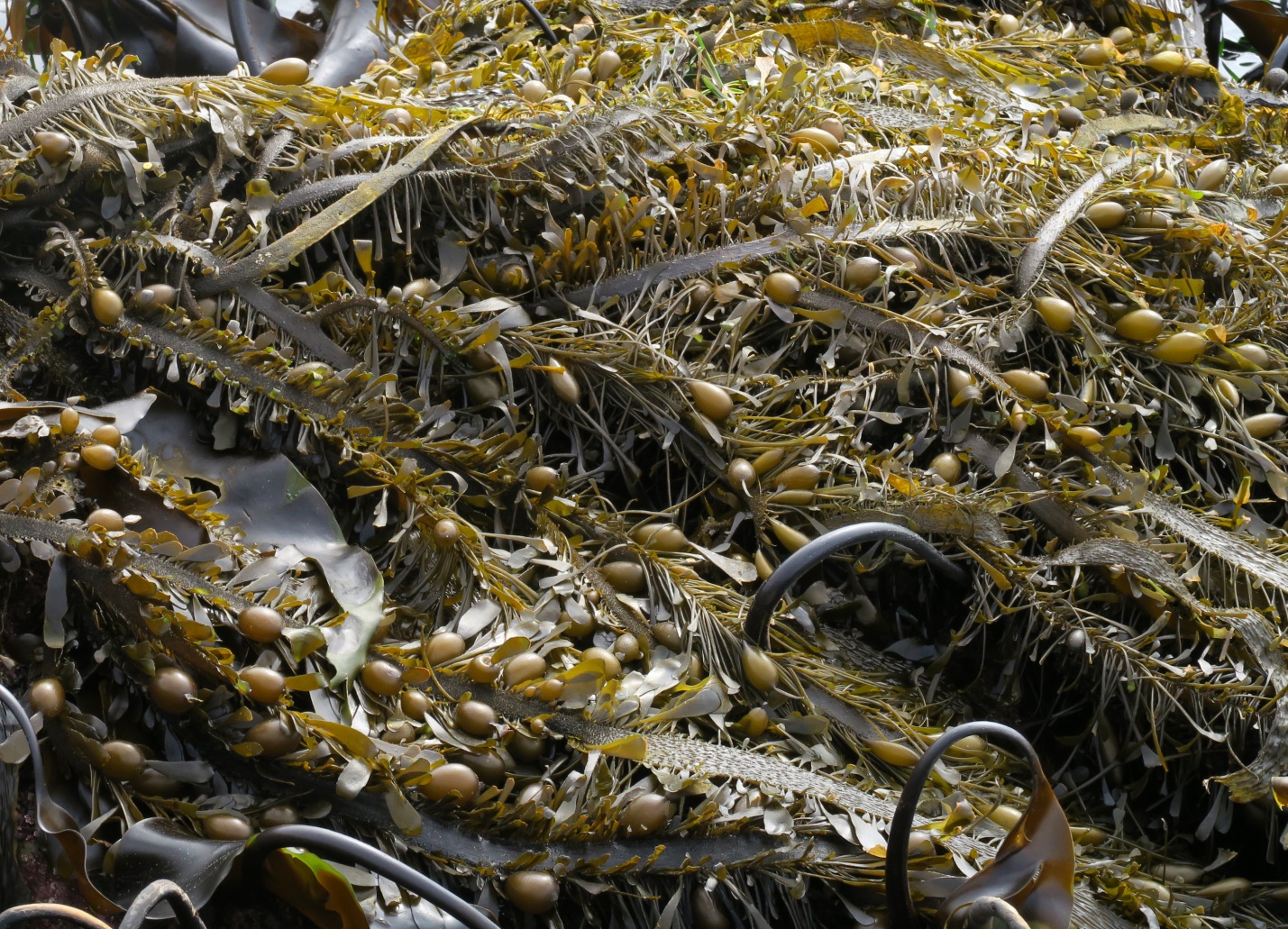
Figure 6: This picture is brimming with Feather Boas – and it clearly depicts the flattened strap like central stipes, and the profusion of side appendages including pneumatocysts. There’s a lot going on with this kelp species, indeed. Fishboat Bay, Juan de Fuca Strait, B.C., Canada. July 6, 2020. Photo ID 27480 ©Seaweedwhisperings.com
Discussion:
One problem we perceived is that Egregia menziesii wants to be noticed. It’s showy but is rarely appreciated.
One experience of this: at Orveas Bay with 10 year old child, and her showy, sensual dance that I (and others with her at the beach that day) did not want to engage in; she was greatly disappointed.
Another experience that has the same feel is when Person 2 is displaying stuff she is good at, expressing knowledge, or physically constructing something, enthusiastically sharing ideas – and no one could care less. Or, they sort of care but they do not engage.
The problem in both examples is that the Egregia energy “DEFLATES” when they don’t get the engagement they are seeking.
So.
What does Egregia then do?
Retreat and hide – just blends into the background, basically disappears.
Put up protection – toughness of stem, and the wiry, edgy, barrier of moving fronds.
Display a distraction / costume / external enhancements – pretty floats, dancing movement of long (up to 15 meters) central stipe, and flapping motion of side projections.
The solution might be that you embrace who you are, Egregia, and simply continue to be showy – and you let go of engagement with others. You are comfortable in your being just the way you are – ‘showy’ doesn’t need to get you anything, ‘outstanding’ doesn’t need a response. There is a beautiful self-recognition that is sufficient; anything more is welcome, but not needed.
Putting up those protections or hiding can be appropriate as solutions, when they are a choice. Egregia’s problem appears when hiding and protection are the main way of being – when those protections / reactions become the person / personality rather than an appropriately chosen solution.
Person 1 noted that Person 2 frequently adds phrases that equated to Person 1 as embellishments or adornments that he felt did not necessarily add anything to the concept. This fits perfectly with Egregia!
Person 2, when told this, agreed that she identified with the sense that there was something to be added, something of importance, that it was not, in fact, irrelevant or unnecessary.
Egregia menziesii is a monotypic species in its genus. There are no close relatives. Maybe this is part of the drive it has to engage with others? Maybe this is why it was ‘stuck’ with a species name that sounded so foreign and not really fitting? There quite simply aren’t any near similars.
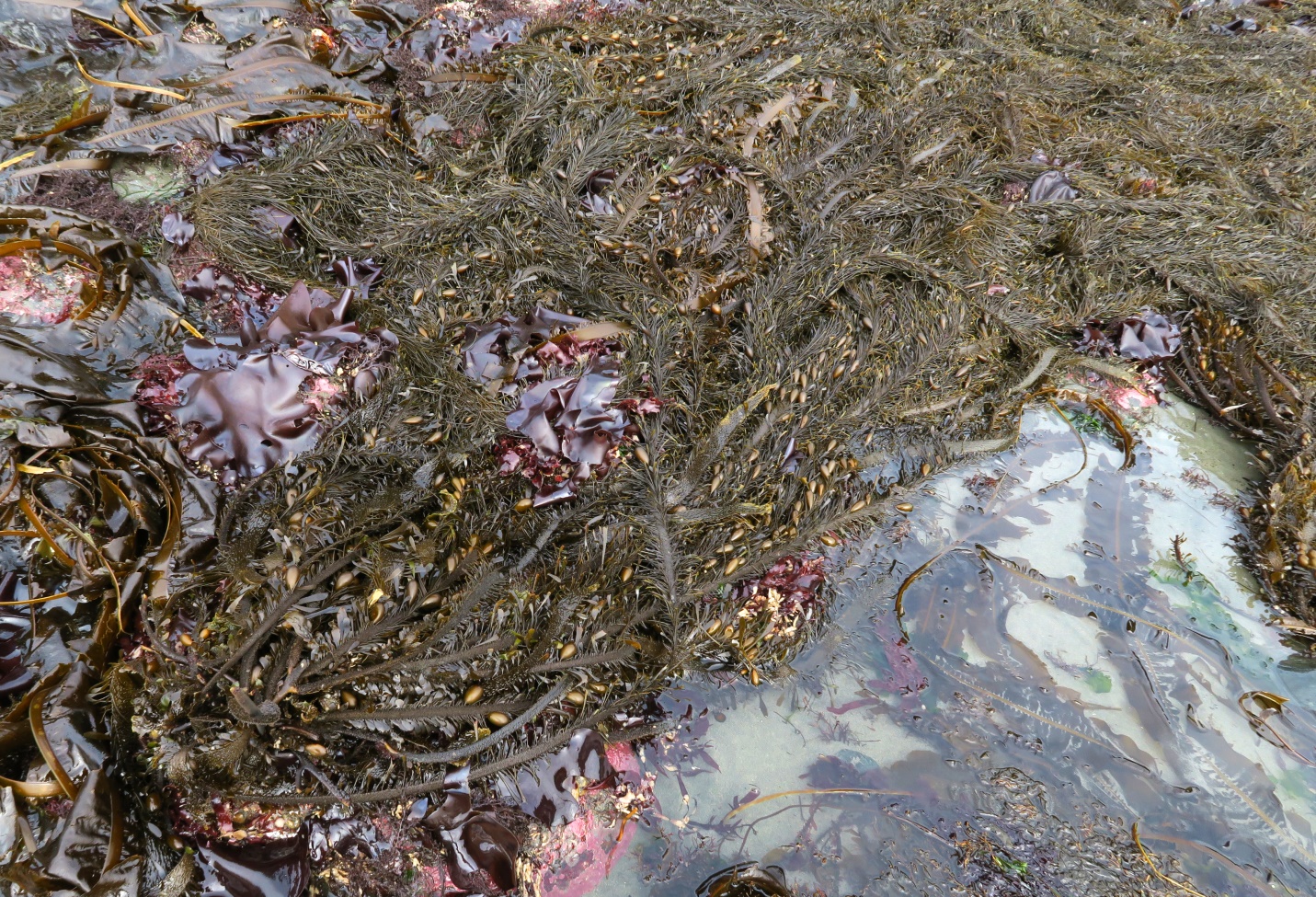
Figure 7: Pictured here are the multiple Feather Boas that all arise from the single holdfast area in the lower left corner of the photo. Profusion of growth is obvious with these Egregia individuals! They share space in the intertidal zone here with Mazzaella splendens and Alaria marginata; they are protecting from desiccation many other algae underneath their blades. As soon as the tide returns the multiple floats of the Feather Boas will lift them above the smaller algae and each will have suitable space to flourish. Fishboat Bay, Juan de Fuca Strait, B.C., Canada. July 6, 2020. Photo ID 27481 ©Seaweedwhisperings.com
Biology & Natural History Information:
Description:
Thallus begins with a conical shaped holdfast that is comprised of richly branched haptera which often becomes gnarly looking with age; from this arise the long strap-shaped stipes that may grow up to 15 meters in length. With a mature specimen there are typically numerous long branches that arise from one (or a few) initial holdfast branches, and these occur as randomly positioned outgrowths. The flattened stipe is covered densely with papillae and bears innumerable lateral appendages along the margins. Some of these are pneumatocysts (ellipsoidal shaped floats) and some are variously shaped blades (often flat and spatulate); the blades grow between 5 and 8 cm in length. This fringe of lateral blades and floats is prolific and dense in individuals in the northern part of their range, while in the more southerly locales the fringe is sparser. This perennial brown algae ranges in color from olive green to dark brown.
Reproduction: Some of the lateral blades serve as sporophylls and become completely covered with microscopic sporangia (spore forming organs). These sporophylls, which are shorter and more narrow than the sterile blades are scattered along the stipe. Sporangia can mature at any time during the year but do so most abundantly from spring to fall.
Habitat:
Feather Boa Kelp grows on rocks in the mid-intertidal and subtidal (to 20 meters in depth) zones. It is found along moderately exposed open coast shorelines.
North Pacific Distribution:
Southern Southeast Alaska to Baja California, Mexico. The genus is endemic to this region of the northeastern Pacific.
Remarks:
Like Giant Perennial Kelp and Bull Kelp, this massive seaweed species, elevated from the sea bottom by its many small gas-filled floats (pneumatocysts) which are positioned all along the central main branches, creates an extensive underwater forest and sheltering canopy for many creatures (young fish, invertebrates and marine mammals). The canopies of Feather Boa are typically in shallower water than those created by Nereocystis luetkeana and Macrocystis pyrifera, and sometimes a mix of Macrocystis and Egregia create a blended canopy. Throughout much of its range Feather Boa also serves as habitat for the tall-shelled Seaweed Limpet (Notoacmea incessa), which lives and feeds on the superficial tissues of the Feather Boa and also on its epiphytes.
Phycologists speculate that Egregia represents the initial departure of kelp from a Fucus-like ancestor. Egregia menziesii is the only species in the monotypic genus, Egregia. There are, however, considerable molecular genetic similarities shared by all kelp and this taxonomic question remains unanswered at present. There is some recent research that suggests that Feather Boa is a relatively warm water species. In the past several years the population density of Egregia is increasing while two colder-water-preferring kelp, Alaria marginata and Saccharina sessilis are declining, especially along the outer coast of Vancouver Island. This change seems to signal a general warming of the waters in this region.
“Menziesii” is for Archibald Menzies, botanist during Captain George Vancouver’s voyages from 1791 to 1795.
Classification:
Phylum: Ochrophyta
Class: Phaeophyceae
Order: Laminariales
Family: Lessoniaceae
Genus: Egregia
Species: Egregia menziesii (Turner) Areschoug 1876
Former name(s): Fucus menziesii Turner 1808; Egregia laevigata f. borealis Setchell 1901 is considered to be a synonym of Egregia menziesii.
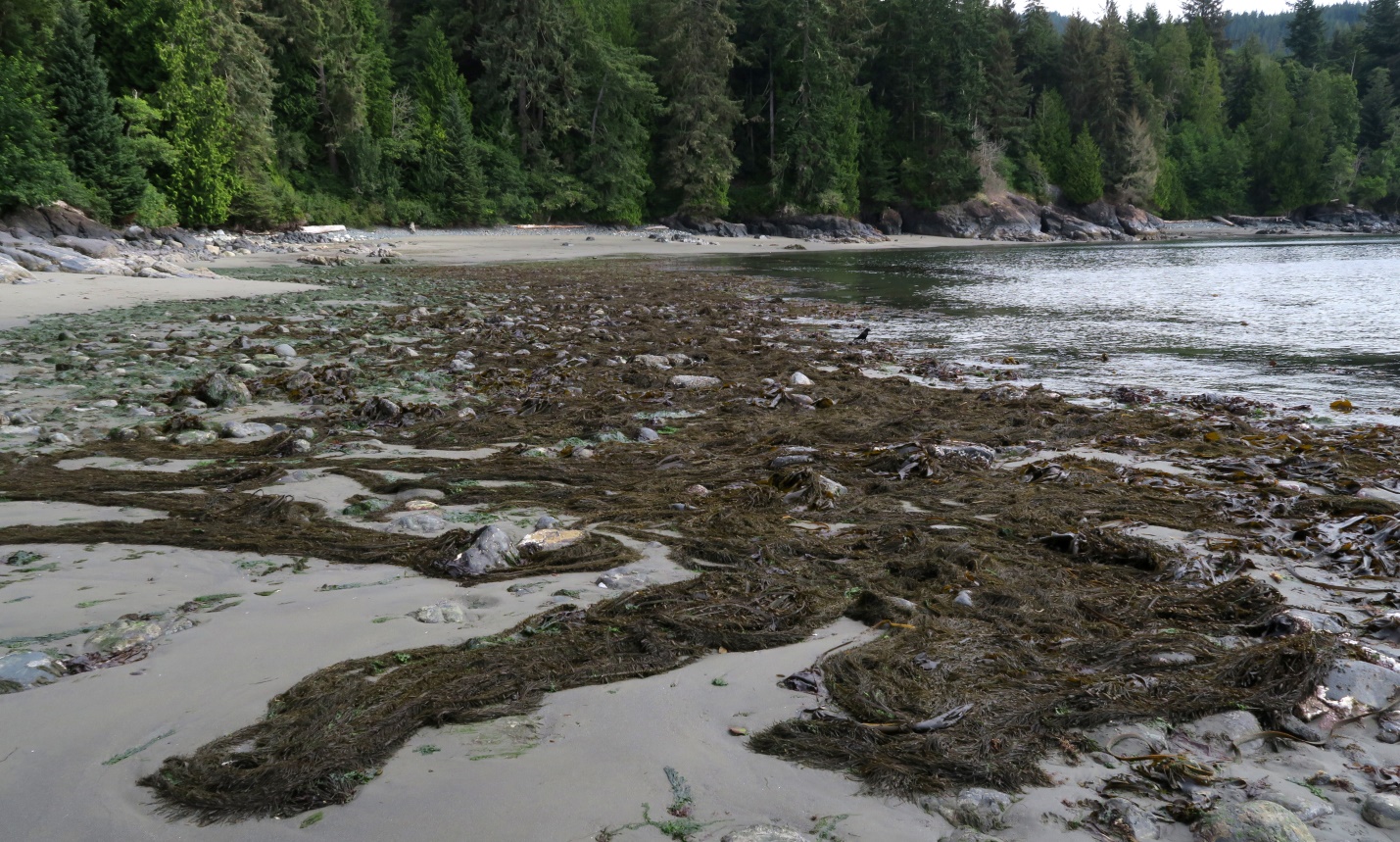
Figure 8: On this zero foot low tide morning the cobble and sand beach is carpeted with large patches of ‘resting’ Feather Boa Kelp. Many other macro algae are also here but the Egregia individuals are a prominent presence (and they are sizeable enough to distinguish from this distance); they even can appear to be dominant as they are often the last to seaweed to lie down when the tide recedes - their floats keep them aloft so very effectively. July 6, 2020. Photo ID 27482 ©Seaweedwhisperings.com
![]()